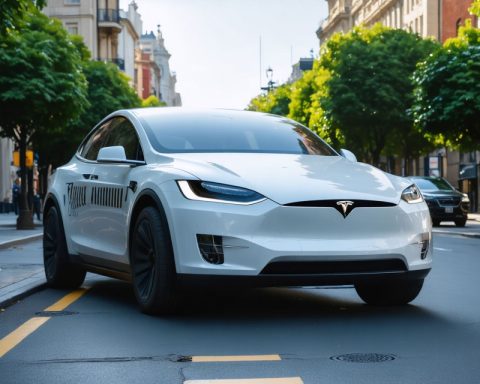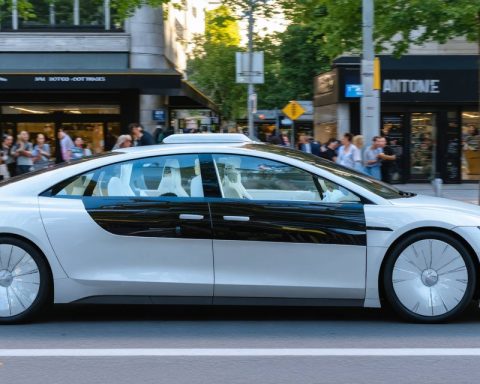- The DEVCOM CBC at Aberdeen Proving Ground pioneers advanced security technologies, integrating AI and robotics to enhance troop protection.
- Lester Strauch, III leads efforts to equip autonomous vehicles with modular chemical and biological threat detection capabilities.
- Autonomous vehicles analyze data at high speed, improving decision-making and safeguarding soldiers from hidden threats.
- The initiative showcases scalable, flexible detection systems merging state-of-the-art technologies for heightened battlefield readiness.
- DEVCOM encompasses a range of competencies, from rocket propulsion to next-gen drones, emphasizing robots and AI as battlefield allies.
- The DEVCOM Chemical Biological Center is the DoD’s main hub for non-medical chemical and biological defense across key U.S. sites.
- This program signifies a tech-driven evolution in warfare, emphasizing the protective power of technological advancements.
Deep within the sprawling expanse of the Aberdeen Proving Ground in Maryland, a technological revolution is brewing, promising to redefine the security framework that protects our troops. The U.S. Army Combat Capabilities Development Command Chemical Biological Center (DEVCOM CBC) stands at this epicenter of innovation, weaving together disciplines from AI to robotics in a pioneering pursuit of safety and readiness.
Amidst the hum of cutting-edge labs and the gleam of technology, Lester Strauch, III emerges as a driving force behind DEVCOM CBC’s transformative initiatives. As a senior industrial engineer, Strauch views challenges through a lens of ingenuity and practicality. In recent strides, he and his team have embraced a modular approach to equipping autonomous vehicles with chemical and biological threat detection capabilities. This isn’t just an upgrade; it’s a leap forward in safeguarding our soldiers from unseen dangers.
Envision a battlefield where autonomous vehicles rove the terrain, perceiving threats with the keen acuity of artificial intelligence and the analytical prowess of machine learning. These unmanned sentinels not only detect chemical and biological dangers but also process information at lightning speed, enabling rapid, informed decision-making without risking human lives. The implications for warfighter lethality and operational readiness are profound.
The genius of this program lies in its integration of state-of-the-art technologies to create a flexible, scalable detection system. Autonomous vehicles, armed with these innovations, act as the eyes and ears on the ground, unyielding in their vigilance. In this evolving theatre of war, readiness is not simply a state—it’s an advantage.
DEVCOM, tasked with leading the Army’s foray into technologically saturated warfare, embodies a wide spectrum of competencies. From pioneering rocket propulsion systems to developing next-generation drones, DEVCOM operates as both architect and engineer of the future battlefield, where robots and AI-driven systems are not just tools but vital allies.
The DEVCOM Chemical Biological Center distinguishes itself as the Department of Defense’s premier hub for non-medical chemical and biological defense. With facilities strategically located at four major sites across the United States, including the esteemed Edgewood Area of Aberdeen Proving Ground, this Center unites a battalion of brilliance—scientists, engineers, and technicians—each contributing to a tapestry of protection against the invisible specters of chemical and biological warfare.
As warfare continues its relentless evolution, this endeavor heralds a new era where our service members stand shielded by technology’s vigilant embrace. In the shadows, autonomous guardians stand ready, ensuring that no soldier strides into peril unprepared.
This initiative isn’t just another notch in the belt of military advancement; it’s a beacon of security and superiority, lighting the path forward. Operating at the intersection of defense and technology, DEVCOM and its Chemical Biological Center lead the charge, committed not just to armament, but to a future where the shield is as potent as the sword.
Revolutionizing Military Defense: The Rise of Autonomous Vehicles in Chemical and Biological Threat Detection
Introduction
The U.S. Army’s DEVCOM Chemical Biological Center is pioneering a new era in military defense technology at the Aberdeen Proving Ground in Maryland. Utilizing cutting-edge technologies such as artificial intelligence (AI), robotics, and machine learning, the Center aims to revolutionize chemical and biological threat detection, ensuring our troops are protected in increasingly complex theaters of war.
Enhanced Features of the Program
1. State-of-the-Art Autonomous Vehicles: These vehicles are equipped with advanced AI systems that enable them to navigate challenging terrains and independently assess threats, providing real-time data to military personnel without endangering human lives.
2. Modular Detection Systems: The system is designed with scalability and flexibility in mind, allowing it to adapt rapidly to various combat situations and threat levels. This modularity ensures the systems can be upgraded as new technologies emerge.
3. Multi-Disciplinary Integration: The DEVCOM CBC harnesses a range of disciplines, from AI to chemical engineering, to provide a comprehensive approach to threat detection, making it a leader in non-medical chemical and biological defense.
Real-World Applications
– Reduced Risk for Soldiers: By deploying unmanned systems in hazardous zones, the risk to human operators is minimized. This is critical in environments where chemical and biological threats are present.
– Improved Tactical Decision-Making: The rapid processing capabilities of these autonomous systems mean faster, more informed responses to potential threats, potentially saving lives and enhancing mission success rates.
– Versatility in Applications: Beyond military use, these technologies could be adapted for disaster response, chemical spill management, and even pandemic containment strategies.
Industry Trends and Market Forecasts
– Growing Investment in Defense Technology: According to a report by Market Research Future, the global autonomous vehicle market in military settings is expected to grow at a compound annual growth rate (CAGR) of approximately 15% from 2021 to 2028.
– Emphasis on AI and Machine Learning: The defense sector is increasingly investing in AI and machine learning technologies to enhance autonomous capabilities, improve threat detection, and optimize logistics in battlefield scenarios.
Pros and Cons Overview
Pros:
– Enhanced Safety: Reducing the need for human presence in dangerous areas.
– Efficiency and Speed: Faster threat assessment and response.
– Adaptability: Systems can be upgraded for future threats.
Cons:
– High Initial Investment: Development and deployment require substantial financial resources.
– Technical Limitations: Current technology may struggle with distinguishing complex threats.
– Ethical Concerns: Increasing reliance on machines in warfare raises ethical questions about decision-making capacities and civilian impact.
Pressing Questions and Answers
– How do these systems ensure accuracy in threat detection?
DEVCOM CBC uses advanced sensors and machine learning models trained on extensive data sets to enhance detection accuracy. Continuous updates and learning cycles improve precision over time.
– What is the sustainability impact of deploying these technologies?
While initial production may have a notable carbon footprint, autonomous systems can increase the sustainability of military operations by reducing resource consumption and minimizing environmental cleanup from human-involved accidents.
– Are there any plans to use this technology in civilian contexts?
As proven reliable and effective, there is potential for adaptation in civilian sectors such as emergency management, environmental protection, and public health.
Conclusion and Recommendations
The integration of autonomous vehicles in chemical and biological threat detection marks a significant advancement in military technology. For military and defense industry professionals, staying abreast of these developments is crucial, as is advocating for continued innovation and ethical deployment.
Quick Tips:
– Stay Informed: Regularly engage with industry publications and DEVCOM reports.
– Advocate for Responsible Use: Encourage discussions about the ethical implications of AI in defense.
– Consider Civilian Adaptations: Explore how military innovations might translate to civilian safety measures.
For more information on cutting-edge defense technology, visit the U.S. Army’s official site.


















